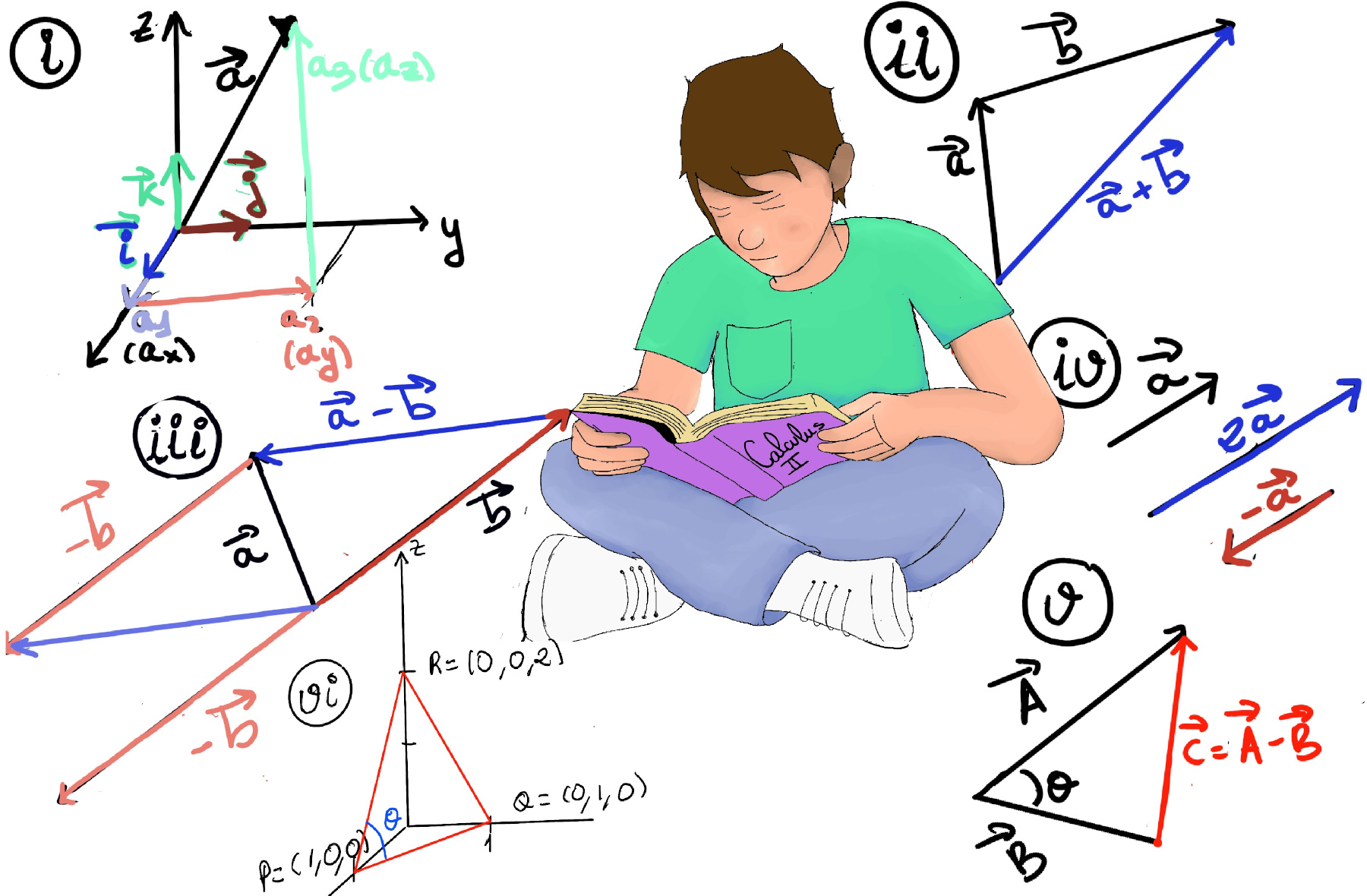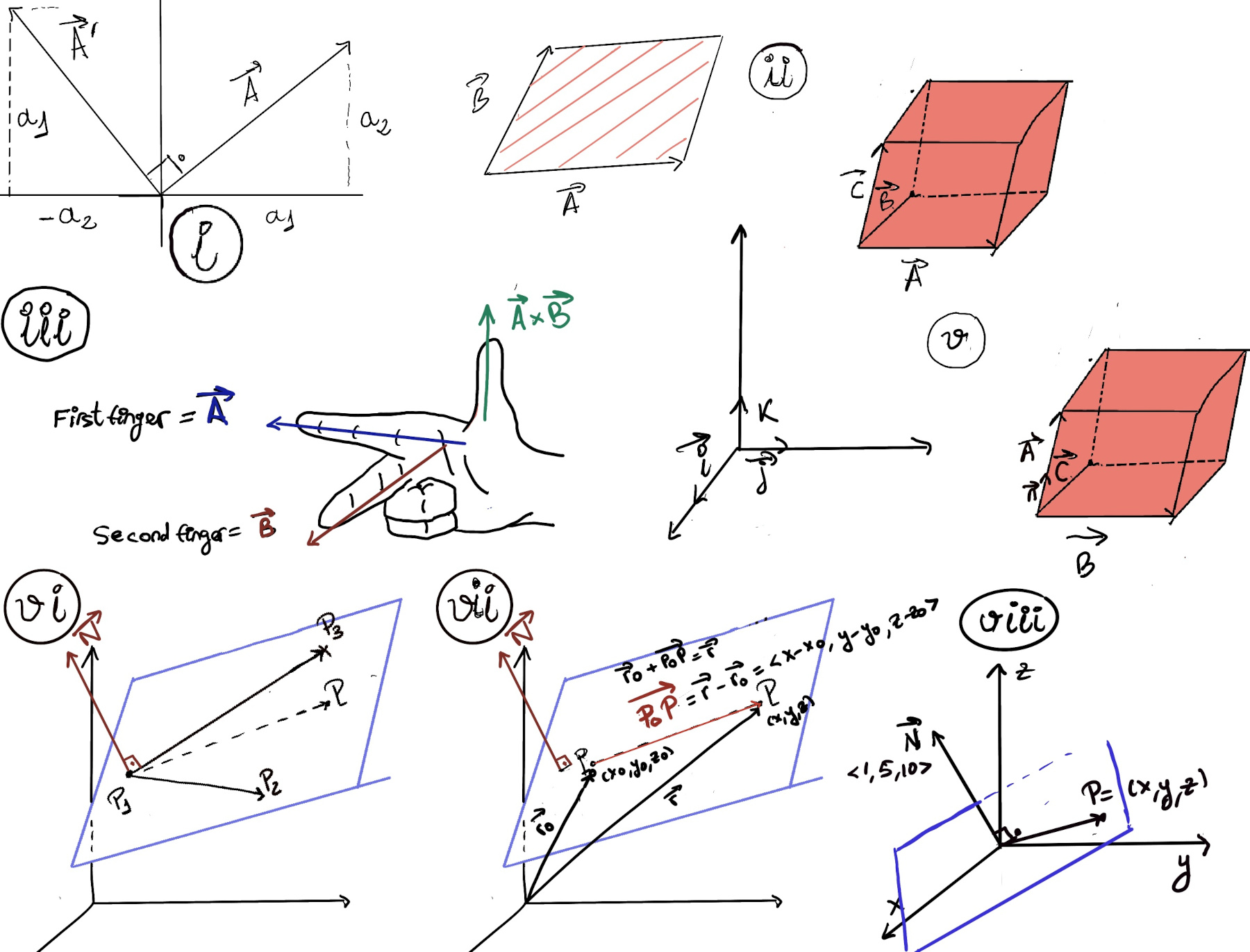
|
 |
 |

|
 |
 |
Irony is wasted on the stupid, Oscar Wilde.
Definition. A vector $\vec{AB}$ is a geometric object that has magnitude (or length) and direction. Vectors in an n-dimensional Euclidean space can be represented as coordinates vectors in a Cartesian coordinate system.
The point A from where the vector starts is called its initial point, and the point B where it ends is called its terminal point. The distance between initial and terminal points of a vector is called the magnitude (or length) of the vector, denoted as $|\vec{AB}|$, or $||\vec{AB}||$. The arrow indicates the direction of the vector.
Typically, the standard basis vectors are often denoted $\vec{i},\vec{j},\vec{k}$ thus $\vec{A} = a_1\vec{i}+a_2\vec{j}+a_3\vec{k}$ = < a1, a2, a3 > (Figure i).
 Definition. The magnitude or length of the vector $\vec{A}$ is given by $|\vec{A}|~ or~ ||\vec{A}|| = \sqrt{a_1^2+a_2^2+a_3^2}$, e.g., $||< 3, 2, 1 >|| = \sqrt{3^2+2^2+1^2}=\sqrt{14}$, $||< 3, -4, 5 >|| = \sqrt{3^2+(-4)^2+5^2}=\sqrt{50}=5\sqrt{2}$, or $||< 1, 0, 0 >|| = \sqrt{1^2+0^2+0^2}=\sqrt{1}=1$.
Definition. The magnitude or length of the vector $\vec{A}$ is given by $|\vec{A}|~ or~ ||\vec{A}|| = \sqrt{a_1^2+a_2^2+a_3^2}$, e.g., $||< 3, 2, 1 >|| = \sqrt{3^2+2^2+1^2}=\sqrt{14}$, $||< 3, -4, 5 >|| = \sqrt{3^2+(-4)^2+5^2}=\sqrt{50}=5\sqrt{2}$, or $||< 1, 0, 0 >|| = \sqrt{1^2+0^2+0^2}=\sqrt{1}=1$.
Definition. Any vector with magnitude of 1, i.e., $|\vec{A}|~ or~ ||\vec{A}|| = \sqrt{a_1^2+a_2^2+a_3^2} = 1$, is called a unit vector.
Subtraction is very similar $\vec{A} - \vec{B} = (a_1-b_1)\vec{i}+(a_2-b_2)\vec{j}+(a_3-b_3)\vec{k}$ = < (a1-b1), (a2+b2), (a3+b3) >, e.g., $\vec{A}-\vec{B} = ⟨2,−1,3⟩ - ⟨−3,4,1⟩ = ⟨5,-5,2⟩$
It may be represented graphically by placing the tail of the arrow b at the head of the arrow a, and then drawing an arrow from the tail of a to the head of b. The new arrow drawn represents the vector a + b and this is called the parallelogram rule because a and b form the sides of a parallelogram and a+b is one of the diagonals.
To subtract $\vec{B}$ from $\vec{A}$, place the tails of $\vec{A}$ and $\vec{B}$ at the same point, and then draw an arrow from the head of $\vec{B}$ to the head of $\vec{A}$.
Intuitively, multiplying a vector by a scalar r stretches it out by a factor of r. Geometrically, this can be visualized as placing r copies of the vector in a line where the endpoint of one vector is the initial point of the next vector. If r is negative, then the vector changes direction or flips around (by an angle of 180°).
Properties, ∀$\vec{v},\vec{u},\vec{w}$ vectors, ∀a, b ∈ ℝ, we have the following properties, $\vec{v}+\vec{w}=\vec{w}+\vec{v}, \vec{v}+(\vec{u}+\vec{w})=(\vec{v}+\vec{u})+\vec{w}, \vec{v}+\vec{0}=\vec{v}, 1\vec{v} = \vec{v}, a(\vec{v}+\vec{w})=a\vec{v}+a\vec{w}, (a+b)\vec{v} = a\vec{v}+b\vec{w}.$
Dot product.
The dot or scalar product is a fundamental operation between two vectors. It produces a scalar quantity that represents the projection of one vector onto another. The dot product is defined as follows: $\vec{A}·\vec{B} = \sum a_ib_i = a_1b_1 + a_2b_2 + a_3b_3,$ e.g. $\vec{A}·\vec{B} = \sum a_ib_i = ⟨2, 2, -1⟩·⟨5, -3, 2⟩ = a_1b_1 + a_2b_2 + a_3b_3 = 2·5+2·(-3)+(-1)·2 = 10-6-2 = 2.$
Properties: $\vec{u}·(\vec{v}+\vec{w})=\vec{u}·\vec{v}+\vec{u}·\vec{w}, (c\vec{v})·\vec{w} = \vec{v}·(c\vec{w})=c·(\vec{v}·\vec{w}), \vec{v}·\vec{w}=\vec{w}·\vec{v}, \vec{u}·\vec{0} = 0, \vec{u}·\vec{u}=||\vec{u}||^2, if~ \vec{u}·\vec{u} = 0 ⇒ \vec{u} = \vec{0.}$
Theorem. $\vec{A}·\vec{B}=||\vec{A}||·||\vec{B}||·cos(θ).$

Proof. Notice that $\vec{A}·\vec{A} = \sum a_ib_i = a_1a_1 + a_2a_2 + a_3a_3 = ||\vec{A}||^2 = ||\vec{A}||^2·cos(0).$
The Law of cosine states: $||\vec{C}||^2 = ||\vec{A}||^2+||\vec{B}||^2-2||\vec{A}||·||\vec{B}||cos(θ)$ (i)
$||\vec{C}||^2 =\vec{C}·\vec{C}=$[Figure v]$(\vec{A}-\vec{B})·(\vec{A}-\vec{B}) = \vec{A}·\vec{A}-\vec{A}·\vec{B}-\vec{B}·\vec{A}+\vec{B}·\vec{B} = ||\vec{A}||^2+||\vec{B}||^2-2\vec{A}·\vec{B}$ (ii)
Combining (i) and (ii), $-2||\vec{A}||·||\vec{B}||cos(θ) = -2\vec{A}·\vec{B} ⇒ 2\vec{A}·\vec{B} = 2||\vec{A}||·||\vec{B}||cos(θ)$ ∎
The dot product between two vectors, say $\vec{a}$ and $\vec{b}$, is based on the projection of one vector onto another. First, let’s replace $\vec{b}$ with the unit vectors that points in the same direction as $\vec{b}$ and call this vector $\vec{u}=\frac{\vec{b}}{||\vec{b}||}$. The reader should realize that $||\vec{u}|| = 1$, i.e., $\vec{u}$ is an unit vector
The dot product of $\vec{a}$ with an unit vector $\vec{u}$, denoted $\vec{a}·\vec{u}$, is defined to be the projection of a in the direction of u, or the amount that a is pointing in the same direction as unit vector u. By forming a right triangle with a and this shadow, you can calculate (by forming a right triangle with the vector $\vec{a}$ and its shadow $cos(θ)=\frac{c_1}{||\vec{a}||} ⇒ c_1 = ||\vec{a}||·cos(θ)$ ) $\vec{a}·\vec{u} = ||\vec{a}||·1·cos(θ) = c_1$ (Figure B). If $\vec{a}$ and $\vec{u}$ were perpendicular, there would be no zero and that corresponds to the case when cos(θ) = cos(π⁄2) = 0, $\vec{a}·\vec{u} = 0.$
Generally, $\vec{a}·\vec{b} =||\vec{a}||·||\vec{b}||·cos(θ) ⇒ |proj_{\vec{b}}\vec{a}| = \frac{||\vec{a}||·||\vec{b}||·cos(θ)}{||\vec{b}||} = ||\vec{a}||·cos(θ), proj_{\vec{b}}\vec{a} = \frac{\vec{a}·\vec{b}}{||\vec{b}||^2}\vec{b}$ (Figure C.).
Similarly, $proj_{\vec{a}}\vec{b} = \frac{\vec{a}·\vec{b}}{||\vec{a}||^2}\vec{a}$, e.g., the projection of $\vec{b}$ = ⟨2, 1, -1⟩ onto $\vec{a}$ = ⟨1, 0, -2⟩, $proj_{\vec{b}}\vec{a} = \frac{\vec{a}·\vec{b}}{||\vec{a}||^2}\vec{a}=\frac{4}{5}⟨1, 0, 2⟩=⟨\frac{4}{5}, 0, \frac{-8}{5}⟩$.
Let $\vec{w} = 2\vec{a}-3\vec{b} = 2(-3\vec{i}+4\vec{j})-3(\vec{i}+2\vec{j})=-9\vec{i}+2\vec{j}; \vec{u}=\frac{\vec{w}}{||\vec{w}||} = \frac{-9\vec{i}+2\vec{j}}{\sqrt{85}} = \frac{-9\sqrt{85}}{85}\vec{i}+\frac{2\sqrt{85}}{85}\vec{j}=\frac{\sqrt{85}}{85}(-9\vec{i}+2\vec{j})$
$\vec{v}=||\vec{v}||·\vec{u} = 3·\vec{u}=3·\frac{\sqrt{85}}{85}(-9\vec{i}+2\vec{j})$

$\vec{PQ}·\vec{PR} = ||\vec{PQ}||·||\vec{PQ}||cos(θ) ⇒ cos(θ) = \frac{\vec{PQ}·\vec{PR}}{||\vec{PQ}||·||\vec{PQ}||} =$ [$\vec{PQ}$ represent the displacement from point P to point Q, then its components can be found by subtracting the components of P from the components of Q = ⟨xq −xp, yq −yp, zq −zp⟩. Another way is this $\vec{OP}+\vec{PQ} = \vec{OQ} ⇒ \vec{PQ} = \vec{OQ} - \vec{OP}$] $\frac{⟨-1,1,0⟩·⟨-1, 0, 2⟩}{\sqrt{(-1)^2+1^2+0^2}\sqrt{(-1)^2+0^2+2^2}}=\frac{1+0+0}{\sqrt{2}\sqrt{5}} = \frac{1}{\sqrt{10}}$ ⇒ θ = cos-1($\frac{1}{\sqrt{10}}$) ≈ 71.5°.
The sign of the dot product $\vec{a}·\vec{b}$ depends on the cosine of the angle between the vectors.
Let say P is a point defined by the given equation.
We can define two vectors, namely $\vec{OP} = ⟨x, y, x⟩, \vec{A} = ⟨1, 2, 3⟩$. where $\vec{OP}·\vec{A} = 0 ↭ \vec{OP}⟂\vec{A}$. It is a plane through the origin O and perpendicular to $\vec{A}$ (Figure A).
AreaTriangle = $\frac{1}{2}·||\vec{A}||·||\vec{B}||·sin(θ)$
Let $\vec{A’} = \vec{A}$ rotated 90° ⇒[$θ’=\frac{π}{2}-θ$ ↭ θ and θ’ are complementary angles] cos(θ’) = sin(θ).
$||\vec{A}||·||\vec{B}||·sin(θ) = ||\vec{A’}||·||\vec{B}||·cos(θ’) = \vec{A’}·\vec{B} =$[🚀]
Let’s rotate $\vec{A} = ⟨a_1, a_2⟩$ 90° counterclockwise (Figure i) ⇒ $\vec{A’} = ⟨-a_2, a_1⟩$. If we rotate $\vec{A} = ⟨a_1, a_2⟩$ 90° clockwise ⇒ $\vec{A’} = ⟨a_2, -a_1⟩$

$\vec{A’}·\vec{B} =$[🚀] $⟨-a_2, a_1⟩·⟨b_1, b_2⟩ = a_1b_2-a_2b_1 =det(\vec{A}, \vec{B}) = [\begin{smallmatrix}a_1 & a_2\\ b_1 & b_2\end{smallmatrix}]$ and its measure ± the area of the parallelogram with sides $\vec{A}~and~ \vec{B}$ (Figure ii).
AreaTriangle = $\frac{1}{2}·|\vec{A}||·||\vec{B}||·sin(θ)| = \frac{1}{2}·|det(\vec{A}, \vec{B})| = \frac{1}{2}·|[\begin{smallmatrix}a_1 & a_2\\ b_1 & b_2\end{smallmatrix}]|$